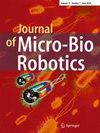Design of microgrippers based on amorphous-crystalline TiNiCu alloy with two-way shape memory
IF 1.1
Q3 ROBOTICS
引用次数: 10
Abstract
Functional layered composites of the shape memory alloys are recently recognized as promising basic active element for microsystem technology and microrobotics. Amorphous-crystalline TiNiCu alloy ribbons at around 40 μm of thickness with an interface separating the amorphous and crystalline phases into layers were produced by melt spinning technique. It is shown that a decrease in the cooling rate of the melt from 8.9·10 5 to 4.2·10 5 K/s leads to an increase in the thickness of the crystalline layer from 2 to 10 μm. The ratio of the thicknesses of the amorphous d am and crystalline d cr layers was also varied by an electrochemical polishing method. The composite ribbons have exhibited the two-way shape memory effect (TWSME) of thermal induced bending deformation without additional thermomechanical training. It was established that when the ratio d cr /d am is changed from 0.06 to 0.35, the minimum bending radius of the ribbon decreases from 37.1 to 6.3 mm, and the maximum reversible strain increases by 0.05% to 0.27%. The minimum time of the shape recovery of the composite ribbons when heated by an electric current pulse was 14 ms, and the force generated by the ribbon with a length of 3 mm in bending reached 1.2 mN. A series of the microgrippers (microtweezers) were fabricated on the basis of the composite ribbons with TWSME. Complete technological process of manipulating graphite filaments with a diameter of 5 to 25 μm using developed microgrippers was demonstrated.具有双向形状记忆的非晶TiNiCu合金微夹持器设计
近年来,形状记忆合金功能层状复合材料被认为是微系统技术和微机器人中很有前途的基本活性元件。采用熔体纺丝技术制备了厚度约为40 μm的非晶TiNiCu合金带,其非晶相与晶相之间存在层状分离界面。结果表明:熔体冷却速率从8.9·10.5 K/s降低到4.2·10.5 K/s,晶层厚度从2 μm增加到10 μm;电化学抛光法还改变了非晶态和晶态镉层厚度的比例。复合材料带状在没有额外的热机械训练的情况下表现出热诱导弯曲变形的双向形状记忆效应。结果表明,当d cr /d am比值从0.06增加到0.35时,带状的最小弯曲半径从37.1减小到6.3 mm,最大可逆应变增加0.05%至0.27%。在电流脉冲加热下,复合带的最小形状恢复时间为14 ms,长度为3 mm的复合带在弯曲时产生的力达到1.2 mN。在TWSME复合带的基础上,制备了一系列微夹钳(微镊子)。演示了利用自制的微夹持器操纵直径为5 ~ 25 μm的石墨丝的完整工艺过程。
本文章由计算机程序翻译,如有差异,请以英文原文为准。
求助全文
约1分钟内获得全文
求助全文
来源期刊

Journal of Micro-Bio Robotics
ROBOTICS-
CiteScore
3.80
自引率
0.00%
发文量
4
期刊介绍:
The Journal of Micro-Bio Robotics (JMBR) focuses on small-scale robotic systems, which could be also biologically inspired, integrated with biological entities, or used for biological or biomedical applications. The journal aims to report the significant progresses in such new research topics.
JMBR is devoted to the theory, experiments, and applications of micro/nano- and biotechnologies and small-scale robotics. It promotes both theoretical and practical engineering research based on the analysis and synthesis from the micro/nano level to the biological level of robotics. JMBR includes survey and research articles.
Authors are invited to submit their original research articles or review articles for publication consideration. All submissions will be peer reviewed subject to the standards of the journal. Manuscripts based on previously published conference papers must be extended substantially.
 求助内容:
求助内容: 应助结果提醒方式:
应助结果提醒方式:


